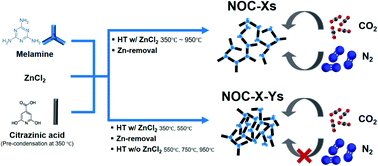Controlling pore size and pore functionality in sp2-conjugated microporous materials by precursor chemistry and salt templating†
Abstract
The synthesis of sp2-conjugated, heteroatom-rich, “carbonaceous” materials from economically feasible raw materials and salt templates is reported. Low cost citrazinic acid (2,6-dihydroxy-4-pyridinecarboxylic acid) and melamine are used as components to form a microporous, amorphous framework, where edges of the covalent frameworks are tightly terminated with nitrogen and oxygen moieties. ZnCl2 as the porogen stabilizes structural microporosity as well as nitrogen and oxygen heteroatoms up to comparably high condensation temperatures of 750 and 950 °C. The specific surface area up to 1265 m2 g−1 is mainly caused by micropores and typical of heteroatom-rich carbon materials with such structural porosity. The unusually high heteroatom content reveals that the edges and pores of the covalent structures are tightly lined with heteroatoms, while C–C or C–H bonds are expected to have a minor contribution as compared to typical carbon materials without or with minor content of heteroatoms. Adsorption of water vapor and carbon dioxide are exemplarily chosen to illustrate the impact of this heteroatom functionalization under salt-templating conditions on the adsorption properties of the materials. 27.10 mmol g−1 of H2O uptake (at p/p0 = 0.9) can be achieved, which also proves the very hydrophilic character of the pore walls, while the maximum CO2 uptake (at 273 K) is 5.3 mmol g−1. At the same time the CO2/N2 adsorption selectivity at 273 K can reach values of up to 60. All these values are beyond those of ordinary high surface area carbons, also differ from those of N-doped carbons, and are much closer to those of organized framework species, such as C2N.



 Please wait while we load your content...
Please wait while we load your content...